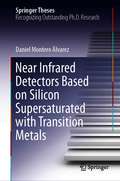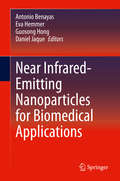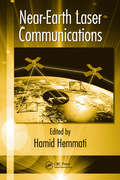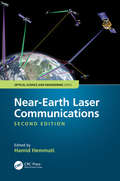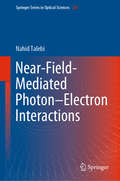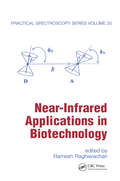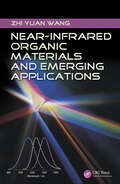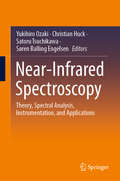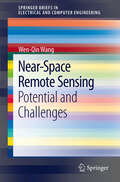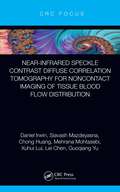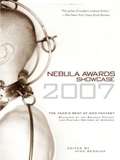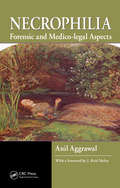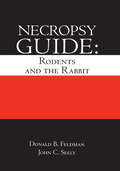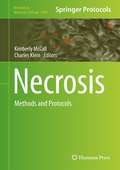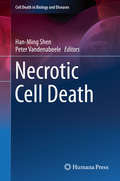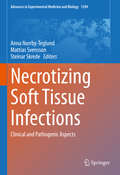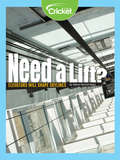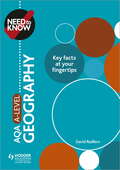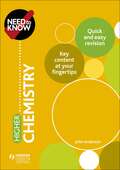- Table View
- List View
Near Infrared Detectors Based on Silicon Supersaturated with Transition Metals (Springer Theses)
by Daniel Montero ÁlvarezThis thesis makes a significant contribution to the development of cheaper Si-based Infrared detectors, operating at room temperature. In particular, the work is focused in the integration of the Ti supersaturated Si material into a CMOS Image Sensor route, the technology of choice for imaging nowadays due to its low-cost and high resolution. First, the material is fabricated using ion implantation of Ti atoms at high concentrations. Afterwards, the crystallinity is recovered by means of a pulsed laser process. The material is used to fabricate planar photodiodes, which are later characterized using current-voltage and quantum efficiency measurements. The prototypes showed improved sub-bandgap responsivity up to 0.45 eV at room temperature. The work is further supported by a collaboration with STMicroelectronics, where the supersaturated material was integrated into CMOS-based sensors at industry level. The results show that Ti supersaturated Si is compatible in terms of contamination, process integration and uniformity. The devices showed similar performance to non-implanted devices in the visible region. This fact leaves the door open for further integration of supersaturated materials into CMOS Image Sensors.
Near Infrared-Emitting Nanoparticles for Biomedical Applications
by Daniel Jaque Antonio Benayas Eva Hemmer Guosong HongThis book analyzes and evaluates the growing field of light-emitting nanoprobes as contrast agents for in vivo imaging and sensing. It is a comprehensive resource that critically analyzes the state of the art in an interdisciplinary manner, with a special focus on the shift of emission wavelengths into the near-infrared (NIR) spectral region (ranging from 0.7 to 2 microns), which has greatly contributed to the latest advances in biomedical imaging and sensing. This book discusses merits of different contrast agents at nanoscale, and how their unique chemical and structural properties lead to the emission and interaction of light within the NIR window. Both the NIR-emitting materials and various surface modification strategies governing their interactions with the biological system at the “nano” level are discussed. Furthermore, different experimental techniques and protocols for NIR-light-based in vivo imaging and sensing are addressed to shed light on further understanding of the advantages and limitations of each category of these nanoprobes. Assembles the state of the art heretofore appearing in scientific literature into a comprehensive, multi-perspective guidebook on near infrared-emitting nanomaterials in an assortment of biomedical applications;Explains the physical, chemical, and biological phenomena underlying near infrared-emitting nanomaterials for biomedical applications;Presents conceptual and experimental approaches surrounding a unique spectral range of light emission from nanosized contrast agents, while offering a clear explanation of basic and general phenomena regarding the interaction between light and biological tissues, such as absorption, scattering and autofluorescence.
Near-Earth Laser Communications (Optical Science and Engineering #1)
by Hamid HemmatiInvented more than a hundred years ago by Alexander Graham Bell, the technology of free-space optical communications, or lasercom, has finally reached the level of maturity required to meet a growing demand for operational multi-giga-bit-per-second data rate systems communicating to and from aircrafts and satellites. Putting the emphasis on near-earth links, including air, LEO, MEO, and GEO orbits, Near-Earth Laser Communications presents a summary of important free-space laser communication subsystem challenges and discusses potential ways to overcome them. This comprehensive reference provides up-to-date information on component and subsystem technologies, fundamental limitations, and approaches to reach those limits. It covers basic concepts and state-of-the-art technologies, emphasizing device technology, implementation techniques, and system trades. The authors discuss hardware technologies and their applications, and also explore ongoing research activities and those planned for the near future. The analytical aspects of laser communication have been covered to a great extent in several books. However, a detailed approach to system design and development, including trades on subsystem choices and implications of the hardware selection for satellite and aircraft telecommunications, is missing. Highlighting key design variations and critical differences between them, this book distills decades’ worth of experience into a practical resource on hardware technologies.
Near-Earth Laser Communications, Second Edition (Optical Science and Engineering #1)
by Hamid HemmatiThis reference provides an overview of near-Earth laser communication theory developments including component and subsystem technologies, fundamental limitations, and approaches to reach those limits. It covers basic concepts and state-of-the-art technologies, emphasizing device technology, implementation techniques, and system trades. The authors discuss hardware technologies and their applications, and also explore ongoing research activities and those planned for the near future. This new edition includes major to minor revisions with technology updates on nearly all chapters.
Near-Earth Object Surveys and Hazard Mitigation Strategies: Interim Report
by National Research Council of the National AcademiesThe United States is currently the only country with an active, government-sponsored effort to detect and track potentially hazardous near-Earth objects (NEOs). Congress has mandated that NASA detect and track 90 percent of NEOs that are 1 kilometer in diameter or larger. These objects represent a great potential hazard to life on Earth and could cause global destruction. NASA is close to accomplishing this goal. Congress has more recently mandated that by 2020 NASA should detect and track 90 percent of NEOs that are 140 meters in diameter or larger, a category of objects that is generally recognized to represent a very significant threat to life on Earth if they strike in or near urban areas. Achieving this goal may require the building of one or more additional observatories, possibly including a space-based observatory. Congress directed NASA to ask the National Research Council to review NASA's near-Earth object programs. This interim report addresses some of the issues associated with the survey and detection of NEOs. The final report will contain findings and recommendations for survey and detection, characterization, and mitigation of near-Earth objects based on an integrated assessment of the problem.
Near-Earth Objects: Finding Them Before They Find Us
by Donald K. YeomansAn insider's look at the science of near-Earth comets and asteroidsOf all the natural disasters that could befall us, only an Earth impact by a large comet or asteroid has the potential to end civilization in a single blow. Yet these near-Earth objects also offer tantalizing clues to our solar system's origins, and someday could even serve as stepping-stones for space exploration. In this book, Donald Yeomans introduces readers to the science of near-Earth objects—its history, applications, and ongoing quest to find near-Earth objects before they find us.In its course around the sun, the Earth passes through a veritable shooting gallery of millions of nearby comets and asteroids. One such asteroid is thought to have plunged into our planet sixty-five million years ago, triggering a global catastrophe that killed off the dinosaurs. Yeomans provides an up-to-date and accessible guide for understanding the threats posed by near-Earth objects, and also explains how early collisions with them delivered the ingredients that made life on Earth possible. He shows how later impacts spurred evolution, allowing only the most adaptable species to thrive—in fact, we humans may owe our very existence to objects that struck our planet.Yeomans takes readers behind the scenes of today’s efforts to find, track, and study near-Earth objects. He shows how the same comets and asteroids most likely to collide with us could also be mined for precious natural resources like water and oxygen, and used as watering holes and fueling stations for expeditions to Mars and the outermost reaches of our solar system.
Near-Field-Mediated Photon–Electron Interactions (Springer Series in Optical Sciences #228)
by Nahid TalebiThis book focuses on the use of novel electron microscopy techniques to further our understanding of the physics behind electron–light interactions. It introduces and discusses the methodologies for advancing the field of electron microscopy towards a better control of electron dynamics with significantly improved temporal resolutions, and explores the burgeoning field of nanooptics – the physics of light–matter interaction at the nanoscale – whose practical applications transcend numerous fields such as energy conversion, control of chemical reactions, optically induced phase transitions, quantum cryptography, and data processing.In addition to describing analytical and numerical techniques for exploring the theoretical basis of electron–light interactions, the book showcases a number of relevant case studies, such as optical modes in gold tapers probed by electron beams and investigations of optical excitations in the topological insulator Bi2Se3. The experiments featured provide an impetus to develop more relevant theoretical models, benchmark current approximations, and even more characterization tools based on coherent electron–light interactions.
Near-Infrared Applications in Biotechnology (Practical Spectroscopy #Vol. 25)
by Ramesh RaghavachariThis volume explores developments in techniques in diagnostics, DNA sequencing, bioanalysis of immunoassays, and single-molecule detection. It promotes the measurement, identification, monitoring, analysis, and application of near-infrared spectroscopy (NIR) to medical and pharmaceutical advances. The text also considers noninvasive methods of NIR for successful, cost-effective, and prompt diagnoses of diseases.
Near-Infrared Organic Materials and Emerging Applications
by Zhi Yuan WangTo physicists and chemists, color means light-emission, absorption, spectrum, and coloration. Near-Infrared Organic Materials and Emerging Applications presents knowledge and applications of invisible "colored" organic materials. Near-infrared (NIR) materials are defined as substances that interact with NIR light, namely, absorption and reflection,
Near-Infrared Spectroscopy: Theory, Spectral Analysis, Instrumentation, and Applications
by Yukihiro Ozaki Christian Huck Satoru Tsuchikawa Søren Balling EngelsenThis book provides knowledge of the basic theory, spectral analysis methods, chemometrics, instrumentation, and applications of near-infrared (NIR) spectroscopy—not as a handbook but rather as a sourcebook of NIR spectroscopy. Thus, some emphasis is placed on the description of basic knowledge that is important in learning and using NIR spectroscopy. The book also deals with applications for a variety of research fields that are very useful for a wide range of readers from graduate students to scientists and engineers in both academia and industry. For readers who are novices in NIR spectroscopy, this book provides a good introduction, and for those who already are familiar with the field it affords an excellent means of strengthening their knowledge about NIR spectroscopy and keeping abreast of recent developments.
Near-Space Remote Sensing
by Wen-Qin WangNear-space is defined as the atmospheric region from about 20 kilometer (km) altitude to 100 km altitude above the Earth's surface. It has received much attention in recent years and several types of near-space vehicles are currently being studied, developed, or employed. "Near-Space Remote Sensing: Potential and Challenges" concentrates mainly on the role of near-space vehicles in bridging the gap between satellites and airplanes for microwave remote sensing applications, providing a top-level system description and aiming to encourage further research. Further, this book also describes several potential applications such as passive surveillance, reconnaissance, and high resolution wide swath remote imaging. The book is intended for geographers, transportation engineers and other researchers involved in remote sensing development and applications, in particular for near-space vehicles. Wen-Qin Wang is an assistant professor at the School of Communication and Information Engineering, University of Electronic Science and Technology of China.
Near-infrared Speckle Contrast Diffuse Correlation Tomography for Noncontact Imaging of Tissue Blood Flow Distribution
by Lei Chen Daniel Irwin Siavash Mazdeyasna Chong Huang Mehrana Mohtasebi Xuhui Lui Guoqiang YuImaging of tissue blood flow (BF) distributions provides vital information for the diagnosis and therapeutic monitoring of various vascular diseases. The innovative near-infrared speckle contrast diffuse correlation tomography (scDCT) technique produces full 3D BF distributions. Many advanced features are provided over competing technologies including high sampling density, fast data acquisition, noninvasiveness, noncontact, affordability, portability, and translatability across varied subject sizes. The basic principle, instrumentation, and data analysis algorithms are presented in detail. The extensive applications are summarized such as imaging of cerebral BF (CBF) in mice, rat, and piglet animals with skull penetration into deep brain. Clinical human testing results are described by recovery of BF distributions on preterm infants (CBF) through incubator wall, and on sensitive burn tissues and mastectomy skin flaps without direct device-tissue interactions. Supporting activities outlined include integrated capability for acquiring surface curvature information, rapid 2D blood flow mapping, and optimizations via tissue-like phantoms and computer simulations. These applications and activities both highlight and guide the reader as to the expected abilities and limitations of scDCT for adapting into their own preclinical/clinical research, use in constrained environments (i.e., neonatal intensive care unit bedside), and use on vulnerable subjects and measurement sites.
Nearest Star
by Jay M. Pasachoff Leon GolubUnlike the myriad points of light we gaze at in the night sky, our nearest star allows us to study the wonders of stellar workings at blindingly close range--from a mere 93 million miles away. And what do we see? In this book, two of the world's leading solar scientists unfold all that history and science--from the first cursory observations to the measurements obtained by the latest state-of-the-art instruments on the ground and in space--have revealed about the Sun. Following the path of science from the very center of this 380,000,000,000,000,000,000-megawatt furnace to its explosive surface, Nearest Star invites readers into an open-ended narrative of discovery about what we know about the Sun and how we have learned it. How did the Sun evolve, and what will it become? What is the origin of its light and heat? How does solar activity affect the atmospheric conditions that make life on earth possible? These are the questions at the heart of solar physics, and at the center of this book. Having made optical solar observations with many solar telescopes and in the rockets and satellites, the authors bring their extensive personal experience to this story of how astronomers study the Sun, and what they have discovered about phenomena from eclipses to neutrinos, space weather, and global warming. Richly illustrated with an assortment of pictures from the latest solar missions and the newest telescopes, this book is a very readable, up-to-date account of science's encounter with our nearest star.
Nearly Zero Energy Buildings and Proliferation of Microorganisms
by Elisa Di GiuseppeThis book provides a concise review of the thermo-physical phenomena which regulate heat and moisture transportation in Nearly Zero Energy Buildings envelopes, and their relationship with the growth of biological organisms. It describes the main microorganisms proliferating on contemporary building elements and within buildings. It also states the consequences of biological growth on durability, aesthetics and human health; and provides the main methods for the analytical and experimental evaluation of proliferation. Finally, through the review of recent developments, remedial actions to counter the biological phenomenon are examined, and an outline is provided for future innovations in a field not yet widely investigated.
Nebula Awards Showcase 2007
by Mike ResnickThis annual publication as chosen by the Science Fiction and Fantasy Writers of America brings together the best of the year's stories, as well as essays and commentary on the current state of the genre and predictions of future science fiction and fantasy films, art, and more. This year's award-winning authors include Joe Haldeman (Novel), Kelly Link (Novella, Novelette), and Carol Emshwiller (Short Story).
Necrophilia: Forensic and Medico-legal Aspects
by Anil AggrawalNecrophilia: Forensic and Medico-legal Aspects is the first text that deals with the scientific aspects of necrophilia from a multidisciplinary point of view. After an introduction that provides a general scientific, social, and historical perspective, this volume:Explores causes and contributing factors, covering biological theories and genetics, as well as trauma, brain anomalies, and substance abuseOffers an original approach to classification, creating ten levels of severity from role playing to homicidal necrophiliaDiscusses necrophilia epidemiology, exploring offender characteristics and habitsProvides 20 case studies of infamous as well as less publicized casesDetails the forensics approach to necrophilia investigationExamines current legislation and mores across the worldExplains the challenges involved with providing expert testimony
Necropsy Guide: Rodents and the Rabbit
by Donald B. Feldman John Curtis SeelyThis laboratory guidebook provides step-by-step procedures that will aid in the dissection and collection of major organs and tissues of the most common species of small animals used in biomedical research. Through extensive use of photographs and illustrations, it guides dissectors through a complete necropsy of each species for the purpose of collecting organs and tissues routinely examined by pathologists. The techniques described enable technicians to perform necropsies on almost any mammal in a precise and logical sequence, and collect tissue properly to avoid diagnostic errors. Morphological differences among the various species are discussed.
Necrosis: Methods and Protocols (Methods in Molecular Biology #1004)
by Kimberly Mccall Charles KleinCell death is an essential process in development, and a major contributor to a wide range of human diseases. Three major classifications of cell death, apoptosis, autophagic cell death and necrosis, have been described for years, and the existence of many more forms of cell death is now accepted. In, Necrosis: Methods and Protocols experts in the field provide a wide range of methods and techniques for the study of necrosis in vitro and in vivo. These include methods and techniques for the analysis of necrosis in mammalian cells, characterization of alternative forms of cell death: entosis and pyroptosis, and analysis of cell death in non-mammalian model sytems and mammalian tissues, including chapters on skin, brain, and heart. Written in the highly successful Methods in Molecular Biology series format, chapters include introductions to their respective topics, lists of the necessary materials and reagents, step-by-step, readily reproducible laboratory protocols, and key tips on troubleshooting and avoiding known pitfalls. Authoritative and practical, Necrosis: Methods and Protocols describes techniques in an easy to follow manner, with details so that beginners can succeed with challenging techniques.
Necrotic Cell Death
by Peter Vandenabeele Han-Ming ShenStarting with discussion of basic concepts and the molecular mechanisms of necrosis, this book looks first at several forms of necrotic cell death that have been identified, including necroptosis, autophagic cell death, and PARP-mediated cell death. As necrotic cell death is increasingly known to play a critical role in many physiological processes, the next chapters discuss its effect on metabolism, inflammation, immunity, and development. Necrotic cell death is closely implicated in human diseases like cancer, so the next chapters examine its relevance to human diseases, and final chapters cover methodologies for measuring necrosis. This book presents comprehensive coverage of necrosis from recognized experts from leading academic and medical institutions around the world. In contrast to apoptosis, well-defined as a form of programmed cell death, necrosis used to be considered as accidental (i. e. , non-programmed) cell death, usually in response to a severe injury. Accumulating evidence now suggests, however, that necrosis is also programmed and controlled by distinctive "death machinery" in response to various stimuli like oxidative stress or DNA damage.
Necrotizing Enterocolitis
by Brian F. GilchristThe literature on NEC (necrotizing Enterocolitis), especially in the major textbooks, merely recapitulated what had been written in the past; there has been no new guidance. NEC was viewed as a fait accompli; a sometimes-dire disease that was to be confronted only after it reared its perfidious head. This monograph asks the reader to rethink their
Necrotizing Soft Tissue Infections: Clinical and Pathogenic Aspects (Advances in Experimental Medicine and Biology #1294)
by Anna Norrby-Teglund Mattias Svensson Steinar SkredeThis volume aims to enhance the current understanding of clinical features, treatment and pathogenic aspects in necrotizing soft tissue infections. Various representative case studies are discussed to enhance the readers’ understanding of these complex diseases. Necrotizing soft tissue infections are rapidly spreading infections that may cause extensive soft tissue or limb loss, multiorgan failure and are associated with a considerable fatality rate. It is undisputed that rapid diagnosis and prompt intervention is directly related to survival. The initial presentation may be limited to unspecific symptoms such as tenderness, swelling, erythema and pain. Thus, diagnosis and management are challenging due to heterogeneity in clinical presentation, in co-morbidities, in microbiological aetiology, as well as in the pathogenic mechanisms. An international and multidisciplinary consortium, INFECT, has for the last 6 years been pursuing research aimed to advance the understanding of the clinical and pathogenic aspects of these infections. A central part has been to create a comprehensive clinical registry and associated biobank which have also formed the basis for the experimental studies. Using the INFECT patient cohort, as well as an integrated systems biology approach in patients and clinically relevant experimental models, an advanced insight of diagnostic features, causative microbial agents, treatment strategies, and pathogenic mechanisms (host and bacterial disease traits and their underlying interaction network) has been obtained.
Need a Lift?
by Maria Parrott-RyanBig cities will soon boast supertall and megatall skyscrapers. This means we’ll need elevators that can safely handle them! Engineers are busy rising to the challenge of designing high tech elevators to help people reach these new heights.
Need to Know: Aqa A-level Geog Epub
by David RedfernExam board: AQALevel: A-levelSubject: GeographyFirst teaching: September 2016First exams: Summer 2017 (AS); Summer 2018 (A-level)Find what you need to know, when you need it, with key facts at your fingertips for AQA A-level Geography.Keep this course companion by your side throughout your A-levels so you can check content, review your understanding, use quick tips for success and improve your exam performance.Written by an experienced teacher, author and former senior examiner, this book will help you to:- Build on your learning throughout the course by reinforcing the key facts, terms and concepts from the AQA A-level Geography specification- Answer exam questions more effectively with tips on exam technique, mistakes to avoid and important things to remember- Revise with confidence using 'Do you know?' questions at the end of each topic and more in-depth questions at the end of each sectionThis book covers the following topics:Component 1: Physical geography- Section A: Water and carbon cycles- Section B: Coastal systems and landscapes - Section C: HazardsComponent 2: Human geography- Section A: Global systems and global governance- Section B: Changing places- Section C: Contemporary urban environments
Need to Know: Higher Biology
by Graham Moffat Billy DicksonExam board: SQALevel: HigherSubject: BiologyFirst teaching: September 2018 First exams: Summer 2019 What do you really need to know for the SQA Higher Biology exam?This revision guide covers the essentials in less than 100 pages, so it's perfect for early exam preparation or last-minute revision.- Find key content at your fingertips with quick summaries of the concepts, processes and terminology that you need to understand- Get a better grade in your exam with tips on exam technique, mistakes to avoid and important things to remember- Revise and practise using end-of-topic questions and in-depth questions at the end of each section - with answers provided online - Benefit from the knowledge of experienced teachers, examiners and authors Graham Moffat and Billy Dickson
Need to Know: Higher Chemistry
by John AndersonExam board: SQALevel: HigherSubject: ChemistryFirst teaching: September 2018 First exams: Summer 2019What do you really need to know for the SQA Higher Chemistry exam?This revision guide covers the essentials in less than 100 pages, so it's perfect for early exam preparation or last-minute revision.- Find key content at your fingertips with quick summaries of the concepts, processes and terminology that you need to understand- Get a better grade in your exam with tips on exam technique, mistakes to avoid and important things to remember- Revise and practise using end-of-topic questions and in-depth questions at the end of each section - with answers provided online - Benefit from the knowledge of experienced teacher, author and examiner John Anderson
